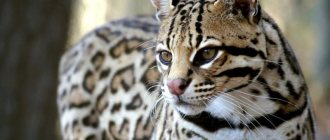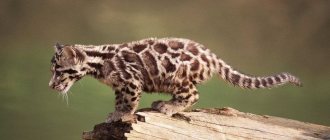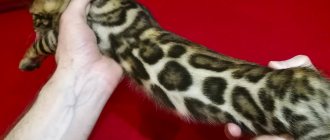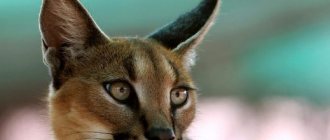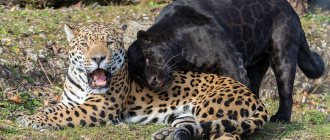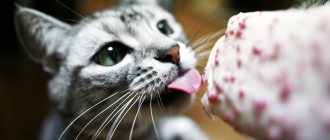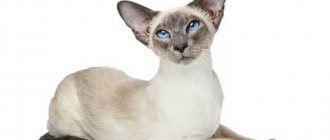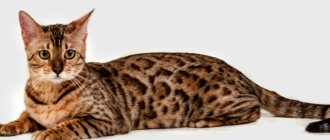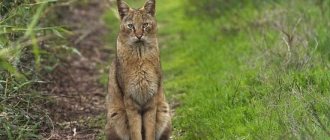The ocelot is a wild cat that is found in South and North America and has one of the most beautiful colors of all cats. Outwardly it resembles a small leopard. Weighs about 13 kg, and the length of the body including the tail is about a meter. Ocelots are rarely kept as pets, they are difficult to tame and are listed in the Red Book, which means that the capture and sale of animals is strictly controlled.
Where does the ocelot come from?
These bright cats are home to two continents - all of South America is inhabited by numerous subspecies of ocelot. And in the neighboring part of the American continent, animals have chosen the central region, which includes Mexico and neighboring states, as well as the southern states of the United States.
Ocelots are indigenous to Central and South America
Zoologists do not have exact information about why ocelots were named that way. Some scientists say that the name of the species comes from a modified Aztec word tlacelot, meaning something like “field tiger” or “steppe jaguar.” Other researchers generally believe that it all began with the tribal name Océlotl, which was used to refer to groups of Indians on the Texas prairie. Well, the official name of this feline species is Felis pardalis, which is translated from Latin as “leopard cat.” Indeed, graceful purrs are similar to young leopards, only the animals belong to different genera within their motley family.
The history of the ocelot, like predators like it with an elegant fur coat, is very sad. Currently, the animal is listed in the Red Book due to a significant decline in the species' numbers throughout the 20th century.
Ocelots are still illegally killed for their beautiful fur.
It all started in the mid-1960s. fashion houses around the world began to use leopard print in clothing. Moreover, preference was given exclusively to natural materials. An unprecedented hunt for ocelots began, because among rich ladies it was a matter of honor to purchase a spotted coat or fur coat with a bright pattern.
According to research, by the beginning of 1970, more than 130 thousand ocelot skins were imported into the United States. At the same time, it became fashionable to have purrs in homes as pets instead of ordinary cats.
Such human activity has sharply affected the number of predators, so much so that in North and Central America the species practically disappeared, and in South America it was found mostly in the jungles of Brazil and Paraguay. Zoologists raised the alarm, and in 1989, ocelots were banned from hunting and the sale of their pelts by the Convention on International Trade in Endangered Species of Wild Fauna and Flora (CITES). The animal was also listed in the Red Book as endangered.
The measures taken led to the fact that by the mid-1990s. the total number of ocelots living in the natural environment ranged from 850 thousand to 3 million individuals. Surprisingly, the spread of animals as pets has contributed to an increase in the number of these wild murks, since the latter adapt well to urban conditions and do not even lose their ability to reproduce.
Video: two ocelots play with each other in the nursery
History of the evolution of the species
Throughout the 20th century, great damage to the population was caused by the popularity of coats made from the velvety fur of the ocelot. The fur of this beautiful cat was valued higher than the fur of the arctic fox, and poachers did not miss the opportunity to profit from the weaknesses of solvent fashionistas.
The word “ocelot” itself is of Indian origin and initially unites all small wild cats as such. The ocelot was called differently in different regions, but naturalists chose this name to designate the species, which began its formation approximately 2.4-1 million years ago. The closest species is margay cats.
In the 21st century, the wild ocelot can most often be found in Mexico and Argentina in the mountains, Amazon rainforests, mangrove swamps and all areas where human traffic tends to zero. In the United States, the ocelot is periodically recorded in Arizona and Texas.
The attractive beauty of the ocelot
Ocelots look so unusual and bright that you want to stock up on a professional camera and endlessly photograph this graceful animal. Every centimeter of the body is decorated either with a coal-black stripe or with a uniquely shaped spot. And in general, these inhabitants of the American jungle are built very neatly and harmoniously.
Ocelots are one of the most prominent representatives of the cat family.
So, what is the appearance of spotted purrs? Despite their apparent resemblance to leopards, ocelots are noticeably smaller in size. Thus, animals grow up to one to one and a half meters in length, including the tail. The weight of an adult animal ranges from 11 to 18 kg, and the height at the withers is on average 50–55 cm.
In addition, ocelots are loved for their expressive appearance features, including:
- muscular body on long, slender legs (the hind legs are noticeably longer than the front);
- powerful head with wide cheekbones and a heavy chin;
- long, sinewy neck, flowing into broad forearms;
- rounded, widely spaced ears;
- large nose (can be either pink or spotted depending on the subspecies);
- large almond-shaped eyes with a bright brown-golden iris and an expressive gaze.
But the most valuable thing about the beauty of an ocelot is its fur coat. Thick, stuffed fur with soft bristles will not leave any animal lover indifferent. But the color can be very diverse, because in the American jungle scientists have discovered as many as 11 subspecies of these handsome cats. And each “clan” has a different fur pattern with a unique arrangement of spots and stripes.
What is common to all ocelots is the basic yellowish-sand color of the pile, on which black and dark brown spots, half rings and stripes are scattered. The latter, however, are located mainly only along the ridge at the base of the head, on the back sides of the paws and on the chest. The tail is framed by wide black-chocolate rings.
It is also worth describing the “war paint” on the animal’s face. Here nature did not spare colors and imagination, making every effort to bring the cat’s beauty. The black edging affects the eyes (they seem to be thickly lined with antimony), the wide forehead (there are two vertical stripes), and the cheeks (they have the classic “tiger” lines).
In general, the pockmarked coat color of ocelots helps them survive in tropical forests, camouflaging their purrs among palm trees and mangroves.
Photo gallery: ocelots in all their glory
Ocelots have very expressive eyes
And wide noses can be either pink or with a dark edging
Ocelots, like other murks, have a lot of charm
And these cats are not deprived of intelligence
At the same time, the ocelot is a proud and capricious predator.
But with a sufficient level of care, this handsome spotted boy will turn out to be an easy-going pet.
However, it is always worth remembering the wild blood flowing in the veins of such a pet.
Diet
Ocelots are carnivorous predators that in nature hunt a variety of small mammals; their diet includes armadillos, possums, rabbits, rodents, small birds, fish, large insects and reptiles.
According to studies by naturalists in the southeastern parts of Brazil, Ocelots mostly feed on primates, and the Mexican subspecies prefer iguanas.
Ocelots most often prey on animals weighing less than a kilogram. Therefore, they rarely attack large prey such as deer and peccaries, because a cat only needs 600-800 g of food daily to meet its energy needs.
The composition of the diet can vary significantly depending on the season and area of residence. Thus, in Venezuela, Ocelots prefer iguanas and rodents during the dry season, and then switch to land crabs during the rainy season.
Scientists believe that Ocelots are similar to their closest relatives in terms of food preferences, but the oncilla specializes more in arboreal marsupials and birds, while the margay is not so selective.
Ocelots, as established by naturalists, followed potential prey to capture prey, relying largely on their sense of smell. The animals are able to spend half an hour in ambush, and then, if the hunt does not take place, they move to a new observation site. They most often kill the prey immediately, and immediately pluck the feathers before eating the birds.
Behind the graceful and bright appearance of an elegant handsome man hides a cruel and merciless killer who, upon overtaking his prey, rips out its throat with one movement of his sharp fangs. The predator does not have chewing incisors, so it tears off pieces of meat and swallows them.
The animal chooses the time to hunt immediately after sunset. Unsurpassed hearing and excellent night vision helps Ocelot to successfully track prey at night in thickets of tall grasses and, more often, dense trees.
If it was not possible to get meat, then Ocelot will not remain hungry, he will come to the river and catch fish, lizards and snakes.
Ocelot in its natural environment
Since jaguar-like cats live over vast areas of the American continent, living conditions in different areas for the ocelot vary. Thus, in Honduras and Ecuador, animals live in jungles open to hunting. And in Brazil and Paraguay, animals were created more comfortable conditions for reproduction, protected by the creation of protected areas.
Ocelots are not protected from extermination in all countries of South and Central America
Well, in the southern regions of the United States (such as Texas or Arizona) and throughout Mexico, it is now almost impossible to find an ocelot. These predators can only be observed in these countries in zoos or with private owners.
Where do the “leopard-like” live?
Despite the Indian name “field tiger,” ocelots are not found in open spaces. These secretive purrs choose to live in dense thickets in the rain forests of the Amazon and similar regions.
Ocelots are very difficult to find in the wild
Like a self-respecting wild cat, the ocelot has been a dexterous tree climber since early childhood. And this is not surprising - during the dry season, at high altitudes it is easier to hide from the sweltering heat. And in deep, dry hollows you can build a cozy and safe nest for the cubs.
At the same time, human activity makes its own adjustments to the preferences of ocelots in choosing a place of residence. Due to continuous deforestation and the rapid reduction of areas with dense vegetation, animals are forced to move to bushy meadows and swamps. And sometimes spotted murki even climb high into the mountains.
Thus, there are known cases when ocelots were spotted between rock crevices in the Andes at an altitude of about 3800 meters above sea level.
But no matter where the ocelot lives, the predator will always try to escape prying eyes and come out of hiding only after dark.
How ocelots live and hunt
Miniature copies of leopards and jaguars are, like the “originals,” nocturnal. You practically won’t see ocelots during the day, because the catfish sleep in their shelters.
Ocelots are brave and agile hunters
When thick darkness falls on the jungle, these graceful animals come out to hunt. Each ocelot controls territories of up to 30 km2. Within their territory, predators look for prey, and then wait for the right moment, hiding in cover - mangroves or tall grass.
But ocelots do not like to jump from trees onto a representative of the fauna chosen as lunch, unlike some wild relatives (for example, European forest cats or margays).
As soon as the prey gets close enough, the ocelot overtakes it with a sharp jump and clasps it with its front paws. This is followed by a powerful bite to the neck that leaves no chance and suffocation.
And this is who gets caught in the sharp teeth and strong claws of ocelots:
- small and medium-sized rodents;
- lizards (mainly iguanas);
- snakes;
- large insects (beetles, butterflies);
- rabbits;
- birds;
- small primates.
If the spotted beauties cannot get food for themselves in the thicket of the forest, then at their own peril and risk they begin to approach a person’s home. And then poultry, small ungulates like donkeys, and even young inattentive piglets can fall prey to the mustachioed hunters.
Behavioral characteristics and reproduction
Ocelots are very inconspicuous inhabitants of the jungle, moving silently between tree branches, vines and dense leaves of bushes.
Ocelots lead a secretive and solitary lifestyle
During the daytime, the mustaches recline in trees and doze, and travel along the ground at night. During the rainy season, they try to hide in hollows and holes more often, because they do not like to get their luxurious fur coat wet.
At the same time, the love of these cats for deep water is also interesting, because if necessary, ocelots can swim considerable distances in search of food. And during the spawning period, when the rivers are teeming with fish, catfish literally settle along the banks in order to feast on easy prey.
Essentially, these are solitary cats who do not like strangers in their territory, be they other animals or humans. Besides humans, the greatest danger to small predators is jaguars. They can hunt not only cubs, but also grown young ocelots.
However, not all purrs of this species live alone; sometimes scientists also track down married couples. Moreover, such unions can last for many years, until the death of one of the animals.
Ocelots breed almost all year round - they do not have a specific mating season. But the greatest peak of activity for the purpose of having offspring occurs in January-March.
Ocelot cats are very caring mothers
Forgetting caution, the males begin to meow heart-rendingly throughout the rain forest, calling females to their territory. When they appear, multiple matings occur, and if other males wander into the domain, skirmishes and bloody fights are inevitable.
The further scenario for the development of events looks approximately as follows:
- the female bears the offspring for 2.3–2.5 months;
- the male guards the territory all this time, and the expectant mother prepares the den;
- 2–3 blind kittens are born in a litter;
- for 1.5–1.6 months, the mother feeds the babies with breast milk;
- Dad at this time obtains food and protects the young family from attacks by other predators;
- from the age of 2 months, kittens begin to eat small rodents and gradually colonize the spaces around the nest;
- When the babies are 4–5 months old, they are taken on their first hunt and begin training.
So, the young animals will spend two years playing and learning about the world around them. After which their parents will simply kick them out of the house, so that the young ocelots can conquer their own lands and begin a full adult life filled with difficulties and dangers.
Well, the cat age of ocelots in natural habitats lasts about 12–14 years.
Reproduction
Mating calls, which allow males and females to find each other during sexual hunting, are similar to ordinary meowing, only greatly amplified. Such screams can be heard over long distances. Ocelots mate throughout the year. The time of maximum sexual activity depends on the region of residence. Thus, animals living in Paraguay and Argentina more often look for a sexual partner in the fall, and residents of Mexico and the state of Texas - in the fall and winter. Estrus in females lasts from three days to a week. If pregnancy does not occur, the female is ready for mating again after 4 weeks.
Biological studies have shown that in wild small cats living in Brazil, maximum sperm production is achieved during the summer months. Having found a suitable female, the male spends several days with his chosen one, without being separated even for hunting and eating. During these days, the couple communicates intensively, constantly sniffing and caressing.
A mother cat usually gives birth to one to three kittens. Pregnancy lasts 77-85 days. To care for the offspring, the mother prepares in advance a comfortable nest, securely hidden among dense thickets. The weight of a newborn kitten is about 300 g. Observations carried out in Texas showed that as mothers grow older, they move their cubs to new places.
For the first two weeks of life, babies remain blind, then the kittens' eyes open. The cubs leave the shelter for the first time when they reach the age of 12 weeks. Adolescents begin to lead an independent life after the age of two, and until then remain under maternal supervision. At 2 years old, young cats can already search for prey without the help of adults and defend their own hunting grounds.
When comparing Ocelots with other felines, biologists note a larger gap between births and a small number of cubs in one litter.
In nature, representatives of the species live 15-20 years, in captivity they can live up to 30 years. Females reach the ability to mate by one and a half years, males - six months later. Another distinctive feature of representatives of the species is the care that males show towards members of their family. The cat does not leave his wife while bearing offspring, and then takes care of the children, protecting them from danger and obtaining food.
Life of an ocelot in captivity
Despite the fact that these spotted cats are listed in the Red Book, their sale in some Central American countries is not controlled in any way.
Ocelots are kept not only in zoos, but also on private property
This policy leads to the fact that it is not difficult to buy an animal that is on the verge of extinction. The only danger is the lack of vaccinations and reliable information about the health of an illegally acquired ocelot.
So it’s safer to contact specialized nurseries or official stores selling exotic animals.
What is the character of a “bonded” ocelot?
These spotted cats, once in the power of humans in adulthood, will never become tame. Moreover, during “mating games” the animal’s behavior can become completely uncontrollable.
Ocelots cannot be tamed as adults
But a kitten acquired before the age of three months (it’s better when it’s still blind) can easily become a cute little kitty. The main thing is to be patient and painstakingly feed your pet from the nipple until it learns to chew the food common to ocelots, that is, meat.
As soon as the little ocelot can move independently, the owner needs to stock up on numerous toys - balls, ropes, brushes and other equipment. After all, the pet will be playful.
But it’s better to select all this “good” in large sizes, that is, look in pet stores in the departments for dogs.
Ocelots raised in captivity retain physical activity and a desire to frolic throughout their lives. And high intelligence makes these predators similar to dogs. Therefore, if desired, the spotted murka can be trained and taught many “dog” commands. Thus, trained cats know how to give their paws and bring things to their owner.
Ocelots also calmly get used to the tray, and from childhood they regularly go to the same place. To prevent the animal from marking its territory, the pet must be neutered at 4 months of age.
At the same time, despite favorable living conditions and love from their households, ocelots forever retain the independence and pride of a wild animal. Therefore, if the slightest discomfort occurs, the mustaches roar and make it clear that they need to be left alone and not violate the boundaries of what is permitted.
Based on the character traits of ocelots, one should remember that it is inadmissible for the animal to communicate with small children under the age of 5–6 years. After all, even an accidental paw strike or bite during play can cause both physical and mental trauma to a child.
And, at the same time, if the ocelot was taken into the house as a two or three month old kitten, the cat will forever become attached to the owner and will relentlessly follow the breadwinner until the last day. And in terms of affection, such animals are in no way inferior to ordinary domestic purrs.
By the way, ocelots have practically no relationship with the latter. Just like with other pets. The leopard cat perceives all living creatures that are smaller than a leopard cat as a target for hunting. And a dog can be mistaken for a competitor on its territory and simply fight with it to the death.
How to keep an ocelot
The leopard-like inhabitants of the Amazon rainforest are accustomed to large spaces and constant physical activity. Based on this, it is necessary for the animal in captivity to create suitable conditions. That is, it is better not to put a handsome guy in an apartment, since the animal will be subject to obesity and joint diseases. And there it is not far from death.
Ocelots need to be kept in spacious enclosures
Therefore, the best option would be to place this very large cat in a wide, comfortable enclosure. The area of the room should not be less than 15 m2, and the height of the fence should not be less than two meters.
Features of setting up an enclosure for a domestic ocelot include the following:
- the floor material should be wooden, and if concrete is used, the surface should be covered with earth or sand to retain heat in autumn and spring;
- next to the main room there should be another one for the animal to live in winter (the temperature inside should not drop below 20 degrees);
- in small areas throughout the entire area, you need to plant flowers (calendula, clover) and herbs (even oats and barley will do), so the animal will have more contact with natural elements;
- Shelves or ladders are built along the walls of the enclosure, saw cuts and branches of trees are placed so that the cat can freely climb on them and sharpen its claws;
- in the far corner of the cage you need to make a den for the predator - a booth or “hut” with straw or unnecessary blankets laid inside;
- it is better to make the fence from mesh than from glass (the latter will create a “greenhouse effect” in the heat and the animal may simply suffocate), and instead of a grille, you can install an “electric shepherd” on top so that the animal does not run away.
It also wouldn’t hurt to equip a small pool in the enclosure so that the ocelot could occasionally splash in the water on summer days or even catch a fish thrown there by the owner.
If your pet has to live in a city apartment, you should definitely walk the handsome spotted dog twice a day. Walks should be long and daily. For these purposes, from infancy the animal is accustomed to a collar and leash, and even better, to a harness.
In the fresh air, the purr will stock up on the necessary amount of vitamin D, as well as psychologically relax and “stretch its bones.” If you're lucky, the catfish will also find the herbs necessary for good digestion, which will provide additional support for the ocelot's health.
How to provide your ocelot with a healthy diet
Since in most cases these wild murkas are purchased from official nurseries, questions about the health of the animals usually do not arise. From a very early age, animals are vaccinated and then also castrated (if the goal is not to breed the breed).
Ocelots at home live a long time with good care
But feeding such a large pet requires special attention. Indeed, in the wild, predators do not always feed regularly, but at the same time, their food is very varied.
In order for the diet to be as close to natural as possible, the ocelot should be offered:
- lean beef;
- veal;
- rabbit meat;
- bird (preferably with feathers);
- fresh fish (no more than once a week);
- “live” food (chickens, quails, rats, mice).
In rare cases, you can add high-quality food for ordinary cats (premium, holistic class) to the menu.
Fresh pork is strictly prohibited, since such meat causes ocelots to develop a dangerous and painful disease - Aujeszky's disease. The disease affects the nervous system, causing fever, seizures and paralysis. Ultimately, the death of the animal follows.
You should not give these cats salt and spices, alcohol, bread, cereals and milk. However, kittens are fed their last food until they are 3–4 months old, and this should be natural cat milk or special artificial milk. As an exception, some owners (in the absence of a nursing cat) pour goat milk into a bottle for baby ocelots.
Since the ocelot is a wild breed of cat, such a pet must have a “fasting day” once a week. That is, the animal is left for a day without food with constant access to clean drinking water. This allows you to maintain the balance of substances in the body and protect the purr from excess accumulation of fat in the muscles.
In general, a “domestic” ocelot should eat no more than 350–550 g of food per day. As a rule, the animal consumes the food offered immediately, leaving no reserves. There should be no more than two feedings per day, and each time the food is given at a different time. This way, the mustache will not get used to a strict routine, but will retain its natural feeding pattern.
We must not forget about the mandatory inclusion of vitamin-mineral complexes in the pet’s menu, especially those with a high calcium content.
Thus, if you follow all the rules in keeping an ocelot and show enough care, the handsome spotted ocelot from the American jungle will live in the family for up to 20 years. The main thing is to love this proud beast and never raise your hand to the cat.
Character and behavior
Ocelots are solitary by nature, strongly attached to their territory and tend to follow habits. They are dexterous and strong, but do not get into trouble and lead a secretive lifestyle. Only at night they go out into open areas of the countryside and, in extreme cases, come close to settlements. Cats communicate with each other using soft meows, they can purr and make some other sounds that turn into loud screams while searching for partners. Kittens, as befits babies, are very playful and curious, but already in the first weeks of life they very clearly demonstrate the hunting instinct.
As for life in captivity, ocelots remain independent and self-sufficient cats, although they show some affection for the person who feeds them. The owners claim that ocelots are very smart animals, they are easy to educate and train, they quickly learn to litter, but even at home they clearly exhibit the habits of wild cats.
How to legally buy an ocelot
As it has already turned out, the illegal purchase of ocelots for small sums leads to the appearance of an unexamined and, most likely, unvaccinated animal in the house. But this is only part of the troubles, because the lack of documents for such a Red Book animal leads to the imposition of an administrative fine and the confiscation of the cat.
Ocelots are difficult to acquire due to the small number of official nurseries in the country
So the only correct and safe way in all respects would be to contact official breeders who have all the documents necessary to keep a wild animal. Russian nurseries, as a rule, cooperate with European ones and supply ocelot kittens to order from there. Or, which is also not uncommon, they independently breed spotted purrs, raising socially adapted and healthy beauties.
Interesting fact! In Russia, the only zoo where they breed ocelots is the Novosibirsk Zoo named after. R.A. Awl. Since 1977, 39 cubs have been born in this institution, and 15 had to be artificially fed.
The only dilemma that the future ocelot owner has to solve is finding the right nursery. After all, on the territory of the Russian Federation and the CIS you can count them on one hand. Two large “boutiques” of exotic pets are located in Moscow, there is one nursery in Krasnodar and one in St. Petersburg.
Well, the approximate cost of an ocelot kitten starts from 400 thousand rubles. and rises to 1.5 million rubles.
In my opinion, ocelots are absolutely beautiful creatures that almost every inhabitant of the planet would like to own. But you should always remember that these are wild predators who love space and lead an active lifestyle. Therefore, in general, it’s good that such beauties cost fabulous money. After all, an owner who has such sums will a priori be able to create comfortable conditions for the animal to live in captivity. Otherwise, it is better to transfer the animal to the reserve so as not to create problems for yourself or the cat.
Interesting Facts
A famous representative of this breed is a cat named Babou, who was a favorite of Salvador Dali. Dali and the ocelot traveled all over the world together. The animal was a reliable and faithful companion to its owner, for which he loved it unquestioningly. Another interesting fact is that the cat is very brave and fearless. Protecting herself and her offspring, she can attack a 2-meter boa constrictor. Ocelot was worshiped by the ancient Egyptians. It was customary to make various figurines and decorations in the image of the animal.
Offspring of a spotted animal
The species has been little studied, but it is already becoming a mystery: why certain subspecies live in pairs, while 45% percent remain solitary. The female copes well and raises her offspring on her own. Like most cats, males are not interested in raising offspring. Moreover, if a pair has formed, then both parents will closely monitor their kittens.
couple's life
When pairing, ocelots must win a female. But the last word remains with her. The ocelot family does not break up for a long time. Only after the death of one of the “spouses” does the partner begin to look for a replacement in 50% of cases.
When offspring appear, the male diligently protects the family and kittens. The two of them get food. The female will join the hunt only after the kittens open their eyes and are able to stand on their feet. Until this moment, only the father of the family brings food.
Singles
The gestation period for a single cat, like a paired cat, will be at least 2 and a half months. Before lambing itself, the female begins preparation. Firstly, creating comfort for yourself and your children. Secondly, she understands perfectly well that for about a week, she will not be able to leave the kittens for a long time. To spend all this time well-fed, she makes preparations. Comes out only when necessary, for a short period of time.
How kittens grow
There is no difference depending on who raises the cubs after they reach 2-3 months (mom or dad). Mother's milk is the main food for small ocelots up to 2 months. Therefore, the mother takes care of the upbringing for the first months. Upon reaching 1.5-2 months, the male joins. By three months, they begin to master the basics of the science of safety and hunting. Adults are considered upon reaching the age of two.
Sources:
https://zveri.guru/zhivotnye/koshki/porody-koshek/kak-zhivet-ocelot-poluchitsya-li-iz-nego-domashniy-kot.html https://obitateli.info/78-ocelot-soderzhanie-v -domashnih-usloviyah.html https://petse.ru/kosh/pr_kosh/ocelot-koshka.html
Characteristic
The largest of the small spotted cats, whose list includes Bengals , Toygers and Savannahs , the ocelot is one of the best-known and most widespread felid species in its range, as well as perhaps one of the most beautiful.
Externally, the animal is similar to a small leopard or a long-tailed cat, although it is larger than it, and smaller than a leopard.
